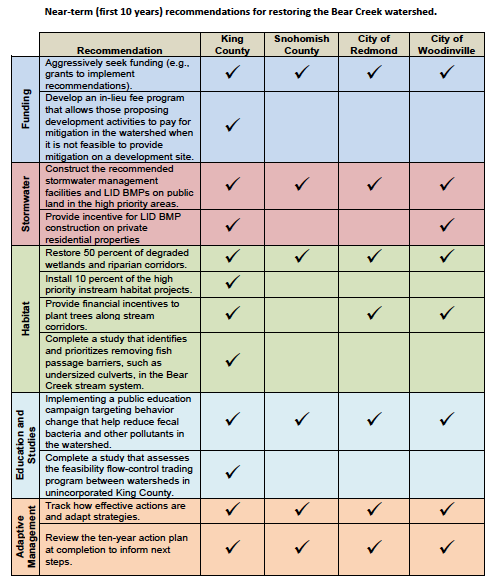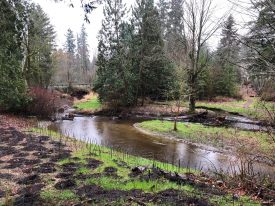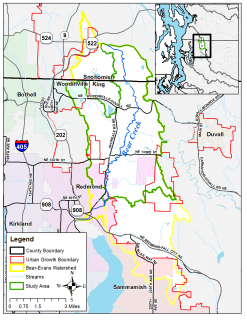by Timothy Clark, Water Quality Planner/Limnologist, King County Water and Land Resources Division
 The Bear Creek Watershed Management Study is a multi-jurisdictional approach to restoring and preserving habitat and water quality in a developed watershed. Restoring and preserving many of Washington’s lakes will likely require work by multiple stakeholders to address similar issues: stormwater, land use, instream habitat, and upland habitat.
The Bear Creek Watershed Management Study is a multi-jurisdictional approach to restoring and preserving habitat and water quality in a developed watershed. Restoring and preserving many of Washington’s lakes will likely require work by multiple stakeholders to address similar issues: stormwater, land use, instream habitat, and upland habitat.
Bear Creek Watershed Management Study
The Bear Creek Watershed Management Study (the Study) is an approach to resolving one of the most challenging environmental issues in the Puget Sound basin – stormwater. Stormwater running off developed lands can carry toxic chemicals, harmful pathogens, and habitat-smothering sediments. Habitat loss and degradation caused by past development, such as decreased stream shading from trees and large changes in streamflow, are negatively impacting salmon and other aquatic life.
King County, Snohomish County, the City of Redmond, the City of Woodinville, and the Washington State Department of Transportation collaborated to complete this Study. The Study provides a comprehensive analysis of the current condition of the Bear Creek Watershed and identifies strategies that would result in clean water and healthy habitat throughout the stream system, with a particular focus on Low Impact Development (LID) best management practice strategies (BMPs). This Study provides a long-term analysis for restoring the Bear Creek Watershed, including a ten-year strategy, approximate budget, and specific proposed projects.
The current state of the Bear Creek Watershed
The study area covers about 26 square miles of the Bear Creek Watershed. Most of the area is in unincorporated King County, with smaller portions in the City of Woodinville, the City of Redmond, and unincorporated Snohomish County. Bear Creek currently supports a wide range of salmon species including Chinook, sockeye, coho, kokanee, steelhead, and coastal cutthroat. Moreover, Bear Creek has been identified as one of two high-priority habitat areas to restore Chinook salmon in the Greater Lake Washington Watershed.
Bear Creek’s water quality, while generally good, is challenged with high levels of fecal coliform bacteria, elevated water temperatures, and low dissolved oxygen levels. The Washington State Department of Ecology has developed measurement levels (the Total Maximum Daily Load or TMDLs) for temperature and bacteria in Bear Creek. Native vegetation along the stream corridor has been degraded over time and historic wetlands have been altered or filled. Instream habitat, critical for salmon and other aquatic life, is lacking in quantity, quality and variety. Bear Creek’s overall aquatic health (based on observed Benthic Index of Biotic Integrity or B-IBI scores) is categorized as “fair.”
Near-term recommendations
The Study found that a substantial effort is needed to achieve the desired objectives. For example, the majority of hard surfaces (roads, driveways, houses, parking lots, etc.) in the watershed would require treatment with low impact development best practices around stormwater management and new or retrofitted stormwater facilities. While the identified strategies reflect the best available science, the effectiveness of many of these actions is still being studied; new approaches and technologies will likely change what is ultimately needed.
King County and its partners recognize the need to act soon – over the next decade – to improve water quality in select small sub-basins in the Bear Creek Watershed. Many factors, including jurisdictional priorities, available funding, and other ongoing activities will affect the way different recommendations are implemented moving forward. Focusing on stormwater actions in smaller geographic areas makes it more likely we can achieve measurable instream improvements earlier, compared to more diffused efforts throughout the watershed. Besides demonstrating results, focused implementation will also provide timely, useful feedback on the strategies used so they can be modified to be more effective, as needed.
Near-term (first ten years) recommendations for restoring the Bear Creek Watershed.
 If fully implemented, the public costs to perform the recommended near-term actions over the ten-year period is estimated at $81 million. The near-term capital construction cost for stormwater facilities in the priority areas on public land is estimated to be $51 million. Near-term capital costs for habitat improvement projects are estimated to be $26 million. Program costs including recommended studies and monitoring are estimated at $4 million ($400,000 per year).
If fully implemented, the public costs to perform the recommended near-term actions over the ten-year period is estimated at $81 million. The near-term capital construction cost for stormwater facilities in the priority areas on public land is estimated to be $51 million. Near-term capital costs for habitat improvement projects are estimated to be $26 million. Program costs including recommended studies and monitoring are estimated at $4 million ($400,000 per year).
Complementary work is already underway and planned to improve watershed health
 Public agencies have already made significant investments to maintain and improve the quality of the Bear Creek Watershed. These include King County’s land conservation and acquisition efforts, salmon habitat recovery projects, road drainage improvements, stormwater retrofits, pollution source control, and Redmond’s Watershed Restoration Plan. The Study reviewed several of the major actions planned for the next 10 years; more than $40 million is already expected to be spent to improve water and habitat quality in the Bear Creek Watershed. Additional investments are also likely as part of projects and programs not reviewed in this Study.
Public agencies have already made significant investments to maintain and improve the quality of the Bear Creek Watershed. These include King County’s land conservation and acquisition efforts, salmon habitat recovery projects, road drainage improvements, stormwater retrofits, pollution source control, and Redmond’s Watershed Restoration Plan. The Study reviewed several of the major actions planned for the next 10 years; more than $40 million is already expected to be spent to improve water and habitat quality in the Bear Creek Watershed. Additional investments are also likely as part of projects and programs not reviewed in this Study.
Public support and involvement are critical
Public involvement, support, and cooperation will be crucial to the success of water quality and habitat restoration efforts in the Bear Creek Watershed. Not only is public support essential for many of the agency strategies identified in the Study, but some strategies — like stream corridor planting and new construction — need to happen on private land. Reducing pollutants in streams requires changing individual behaviors every day. Ultimately, the community’s understanding of Bear Creek’s value to everyone and their commitment to its stewardship is critical to the success of this public-private effort.










